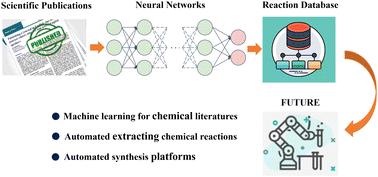当前位置:
X-MOL 学术
›
Chem. Commun.
›
论文详情
Our official English website, www.x-mol.net, welcomes your
feedback! (Note: you will need to create a separate account there.)
A chemical reaction entity recognition method based on a natural language data augmentation strategy
Chemical Communications ( IF 4.3 ) Pub Date : 2024-08-09 , DOI: 10.1039/d4cc01471e Xiaowen Zhang 1 , Yang Li 2 , Chaoyi Li 1 , Jingyuan Zhu 1 , Zhiqiang Gan 1 , Lei Wang 3 , Xiaofei Sun 3 , Hengzhi You 1, 4
Chemical Communications ( IF 4.3 ) Pub Date : 2024-08-09 , DOI: 10.1039/d4cc01471e Xiaowen Zhang 1 , Yang Li 2 , Chaoyi Li 1 , Jingyuan Zhu 1 , Zhiqiang Gan 1 , Lei Wang 3 , Xiaofei Sun 3 , Hengzhi You 1, 4
Affiliation

|
Impressive applications of artificial intelligence in the field of chemical reaction prediction heavily depend on abundant reliable datasets. The automated extraction of reaction procedures to build structured chemical databases is of growing importance. Here, we propose a novel model named DACRER for large-scale reaction extraction, in which transfer learning and a data augmentation strategy were employed. This model was evaluated for chemical datasets and shows good performance in identifying and processing chemical texts.
中文翻译:

一种基于自然语言数据增强策略的化学反应实体识别方法
人工智能在化学反应预测领域的令人印象深刻的应用很大程度上依赖于丰富的可靠数据集。自动提取反应程序以构建结构化化学数据库变得越来越重要。在这里,我们提出了一种名为 DACRER 的新型模型,用于大规模反应提取,其中采用了迁移学习和数据增强策略。该模型针对化学数据集进行了评估,在识别和处理化学文本方面表现出良好的性能。
更新日期:2024-08-09
中文翻译:

一种基于自然语言数据增强策略的化学反应实体识别方法
人工智能在化学反应预测领域的令人印象深刻的应用很大程度上依赖于丰富的可靠数据集。自动提取反应程序以构建结构化化学数据库变得越来越重要。在这里,我们提出了一种名为 DACRER 的新型模型,用于大规模反应提取,其中采用了迁移学习和数据增强策略。该模型针对化学数据集进行了评估,在识别和处理化学文本方面表现出良好的性能。


















































 京公网安备 11010802027423号
京公网安备 11010802027423号